- MOE
- National Parks of Japan
- Bandai-Asahi National Park
- Characteristics
main body
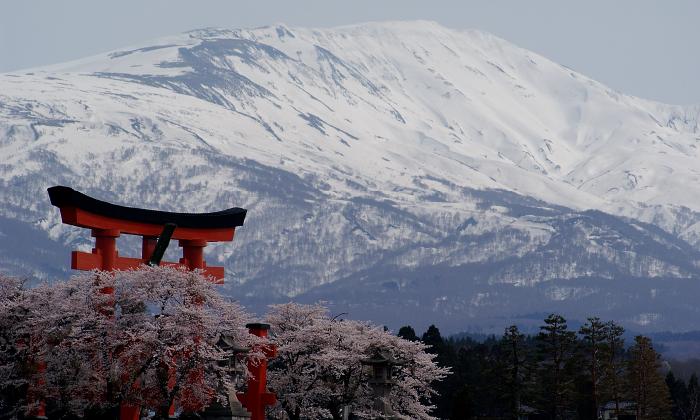
Characteristics
Distant flowers that continue to preserve their ancient form and the land of volcanoes that cannot help but change.
Date of Designation: September 5, 1950
Area: 186,389 ha
Related Prefectures: Yamagata, Fukushima, Niigata
Area: 186,389 ha
Related Prefectures: Yamagata, Fukushima, Niigata
The Bandai-Asahi National Park covers a vast range from the Dewasanzan, Asahi, Iide, and Azuma Mountain Ranges, to Mt. Bandai and Lake Inawashiro, and is Japan's second largest national park on land.
Dewasanzan is famous as a place of mountain worship and has historical appeal. In the Iide and Asahi Mountain Ranges, a highly primitive natural environment has been preserved, and visitors can enjoy the mountainous views surrounded by majestic mountains and the tender beauty of a flower field after a long walk. The Azuma Mountain Range and the area around Mt. Bandai have dynamic views, lakes and marshes of various sizes created by volcanoes and rich forests that are combined to create a beautiful landscape with lots of variety. With convenient access from the urban area, this is popular place where people can enjoy a variety of recreation such as mountain climbing, exploring nature, going to hot springs, and skiing. Bandai-Asahi National Park is filled with plenty of attractions from its mountains with deep forests to its dynamic volcanic area, the lakes and marshes filled with water, and the mountain worship traditions passed over the ages.
Additionally, since the park area covers a vast area of land, there are a wide variety of mountains that can be enjoyed by everyone from beginners to seasoned climbers, and so the park attracts many climbers.
Dewasanzan is famous as a place of mountain worship and has historical appeal. In the Iide and Asahi Mountain Ranges, a highly primitive natural environment has been preserved, and visitors can enjoy the mountainous views surrounded by majestic mountains and the tender beauty of a flower field after a long walk. The Azuma Mountain Range and the area around Mt. Bandai have dynamic views, lakes and marshes of various sizes created by volcanoes and rich forests that are combined to create a beautiful landscape with lots of variety. With convenient access from the urban area, this is popular place where people can enjoy a variety of recreation such as mountain climbing, exploring nature, going to hot springs, and skiing. Bandai-Asahi National Park is filled with plenty of attractions from its mountains with deep forests to its dynamic volcanic area, the lakes and marshes filled with water, and the mountain worship traditions passed over the ages.
Additionally, since the park area covers a vast area of land, there are a wide variety of mountains that can be enjoyed by everyone from beginners to seasoned climbers, and so the park attracts many climbers.
Terrain/ Scenery

Goshiki Pond is also called the "Witch's eyes" (Crater lake of Mt. Azuma)
Bandai-Azuma and Inawashiro Area
Mt. Bandai, Azuma Mountain Range, and Mt. Adatara were formed through volcanic activity. Visitors can view Goshiki Pond at the crater lake close at hand from the peak of Mt. Issaikyo in the Azuma Mountain Range.
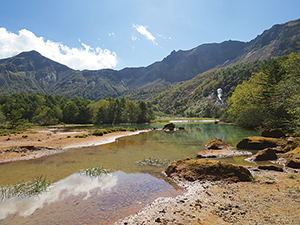
Akanuma Pond (Crater lake of Mt. Bandai)
Additionally, Mt. Bandai has repeatedly had phreatic eruptions and the debris avalanche had dammed the river to form more than 300 lakes and marshes including Lake Inawashiro and Lake Hibara in Urabandai area.
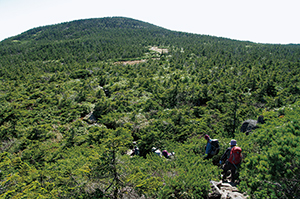
Subalpine Coniferous Forest of Mt. Nishi-Azuma
At Mt. Issaikyo, Akanuma Pond of Mt. Bandai, and Numanotaira of Mt. Adatara, visitors can enjoy the impressive and desolate volcanic scenery. And at Mt. Nishi-Azuma of the Azuma Mountain Range, the virgin subalpine coniferous forests of Abies mariesii and other trees and the mountainous landscape of the wetlands are also very appealing.
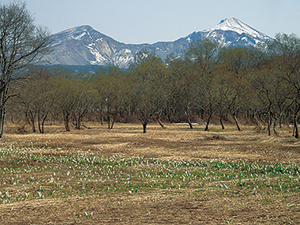
Japanese Alder Forests and Mizubasho (Asian Skunk-cabbage) on the Shores of Lake Hibara
At Urabandai area, located on the north side of Mt. Bandai, you will find a transitional forest of red pine and Japanese alder stretching out before you, created by the effects of a volcanic eruption in the Meiji era.
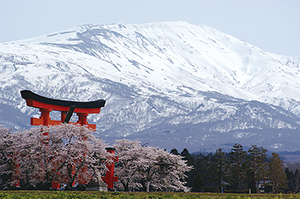
Mt. Gassan (Volcano)
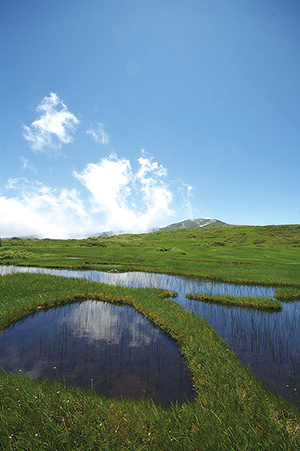
Ponds of Midagahara at Mt. Gassan
Dewasanzan and Asahi Area
Dewasanzan is a collective name for Mt. Gassan (1,984 m above sea level), Mt. Yudono (1,500 m above sea level) and Mt. Haguro (414 m above sea level). Its gentle mountain body was formed from the accumulation of debris from the volcanic eruptions of Mt. Gassan over the folded mountains.
The peak of Mt. Gassan and ridgelines of the Asahi Mountain Range consist of snowpatch grasslands, marshes, windswept grasslands, and communities of dwarf stone pine, and create a landscape of "faux alpine belt" that is devoid of subalpine conifers.
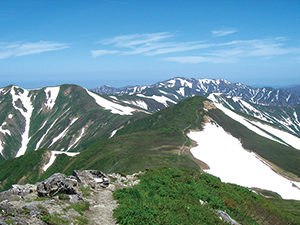
Ridgelines of the Asahi Mountain Range (Non-volcanic mountain range)
The Asahi Mountain Range with its main peak, Mt. O-asahi (1,870 m above sea level) is a non-volcanic mountain range. On the west side of the ridgeline is gentle slopes of periglacial terrain and on the east side is steep slopes created from nivation.
The foothills and mountainsides of this region are covered with dense forests that nurture diverse flora and fauna, and are a habitat for larger mammals and birds of prey that require a large area of natural forest to survive.
Additionally, the high marshes and grasslands are home to plants and insects that have adapted to the harsh environment.
The foothills and mountainsides of this region are covered with dense forests that nurture diverse flora and fauna, and are a habitat for larger mammals and birds of prey that require a large area of natural forest to survive.
Additionally, the high marshes and grasslands are home to plants and insects that have adapted to the harsh environment.
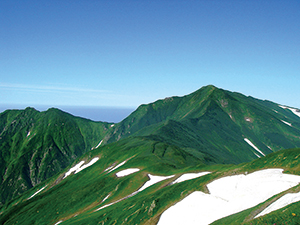
Ridgeline of the Iide Mountain Range (Non-volcanic Mountain Range)
Iide Area
The Iide Mountain Range consists of mountains with peaks 2,000 m above sea level with the main peaks being Mt. Iide (2,105 m above sea level) and Mt. Dainichi (2,128 m above sea level). This is a non-volcanic mountain range formed by the swelling of the sea floor from tectonic activity, and on the west side of the ridgeline is gentle slopes of periglacial terrain and on the east side are steep slopes created from nivation.
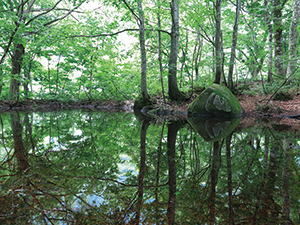
Buna forests in the foothills of the Iide Mountain Range (Nukumidaira)

Autumn Japanese Beech Leaves
The bases and slopes of the Iide Mountain Range are covered in primordial forest. A primitive landscape of primeval Japanese beech forests remains.
Plants
Azuma Mountain Range and Mt. Adatara are home to the Nemotoshakunage, a variant of the Hakusanshakunage (Rhododendron brachycarpum). The Oguninuma marshland is famous for its large community of Hemerocallis dumortiei. Both plants are precious species that are designated as Japan's Natural Monument.
Wildlife
Urabandai is famous for its variety of wild birds and visitors can enjoy bird watching year-round. The foothills and mountainsides of the region of Dewasanzan and Asahi Area are covered with dense forests that nurture diverse flora and fauna, and are a habitat for larger mammals and birds of prey that require a large area of natural forest to survive. Primeval nature is preserved in a large area of the Iide Mountain Range, and it is the habitat for many wild animals such as the large mammals including Asiatic black bears and Japanese serow, as well as small and medium-sized mammals and birds.
Culture
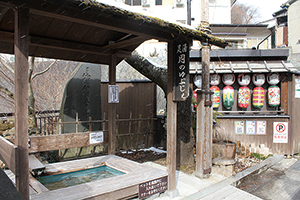
Footbath at Tsuchiyu Onsen
Bandai -Azuma and Inawashiro Area
In the area around the Azuma Mountain Range, there are numerous hot springs, such as Takayu and Tsuchiyu, which are the bounty of volcanoes and provide travelers and mountain climbers with comfort.

Dewasanzan-jinja Shrine and Sanjingousaiden on Mt. Haguro
Dewasanzan and Asahi Area
The Dewasanzan has prospered as a sacred mountain of mountain worship from the ancient times, and has a 1,400 year history that dates back to the middle ages. Even now there are shrines, paths lined with cedar trees, and temple lodgings and the mountains are frequently visited by mountain ascetics and worshipers.
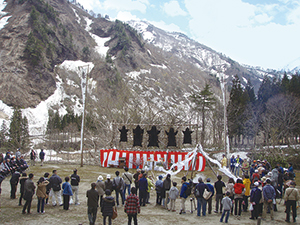
Kumamatsuri (Bear Festival) of Oguni Town
Iide Area
Mt. Iide, the same mountain as Dewasanzan, is a sacred mountain of mountain worship and has long prospered as an ascetic training ground.
Additionally, the villages at the foot of the mountain have passed down a culture of hunting bears using traditional methods.
